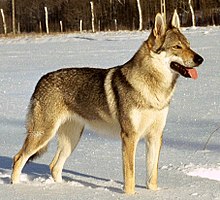This article needs additional citations for verification. (July 2019) |
| Czechoslovakian Wolfdog | |||||||||||||||||||||||||||||
|---|---|---|---|---|---|---|---|---|---|---|---|---|---|---|---|---|---|---|---|---|---|---|---|---|---|---|---|---|---|
 | |||||||||||||||||||||||||||||
| Other names |
| ||||||||||||||||||||||||||||
| Origin | Czechoslovakia | ||||||||||||||||||||||||||||
| |||||||||||||||||||||||||||||
| |||||||||||||||||||||||||||||
| Dog (domestic dog) | |||||||||||||||||||||||||||||

The Czechoslovakian Wolfdog (Czech: Československý vlčák, Slovak: Československý vlčiak, German: Tschechoslowakischer Wolfhund) is a breed of wolfdog that began as an experiment conducted in Czechoslovakia in 1955. The breed was known as Czech Wolfdog (Czech: Český vlčák, Slovak: Český vlčiak) until 1982.[1][2][3]
After initially breeding working line German Shepherds with Carpathian grey wolves, a plan was worked out to create a breed that would have the temperament, pack mentality, and trainability of the German Shepherd and the strength, physical build and stamina of the Carpathian wolf. The breed were originally used as Border patrol dogs but were later also used in search and rescue, Schutzhund sport, tracking, herding, agility, obedience, hunting, and drafting in Europe and the United States.
It was officially recognized as a national breed in Czechoslovakia in 1982, and was officially recognised as a breed by Fédération Cynologique Internationale (FCI) in 1989.
- ^ Štýbr, Jakub. "KAREL HARTL & ČESKOSLOVENSKÝ VLČÁK (2. ČÁST)". psisporty.cz (in Czech). Retrieved 16 October 2023.
- ^ "Krátká historie plemene československý vlčák". wolfdogs.cz (in Czech). Retrieved 16 October 2023.
- ^ "About the breed". The Czechoslovakian Wolfdog Club of GB. 2 May 2020. Archived from the original on 16 January 2024. Retrieved 16 October 2023.